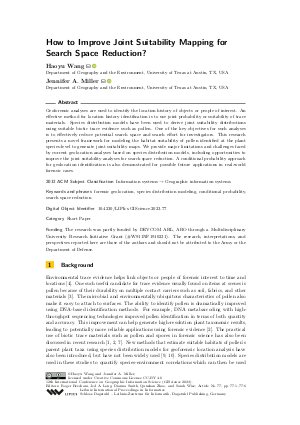How to Improve Joint Suitability Mapping for Search Space Reduction? (Short Paper)
Authors
Haoyu Wang  ,
Jennifer A. Miller
,
Jennifer A. Miller 
-
Part of:
Volume:
12th International Conference on Geographic Information Science (GIScience 2023)
Part of: Series: Leibniz International Proceedings in Informatics (LIPIcs)
Part of: Conference: International Conference on Geographic Information Science (GIScience) - License:
 Creative Commons Attribution 4.0 International license
Creative Commons Attribution 4.0 International license
- Publication Date: 2023-09-07
File

PDF
LIPIcs.GIScience.2023.77.pdf
- Filesize: 1.23 MB
- 6 pages
Document Identifiers
Subject Classification
ACM Subject Classification
- Information systems → Geographic information systems
Keywords
- forensic geolocation
- species distribution modeling
- conditional probability
- search space reduction
Metrics
- Access Statistics
-
Total Accesses (updated on a weekly basis)
0PDF Downloads0Metadata Views
Abstract
Geoforensic analyses are used to identify the location history of objects or people of interest. An effective method for location history identification is to use joint probability or suitability of trace materials. Species distribution models have been used to derive joint suitability distributions using suitable biotic trace evidence such as pollen. One of the key objectives for such analyses is to effectively reduce potential search space and search effort for investigators. This research presents a novel framework for modeling the habitat suitability of pollen identified at the plant species-level to generate joint suitability maps. We provide major limitations and challenges faced by current geolocation analyses based on species distribution models, including opportunities to improve the joint suitability analyses for search space reduction. A conditional probability approach for geolocation identification is also demonstrated for possible future applications in real-world forensic cases.
Cite As Get BibTex
Haoyu Wang and Jennifer A. Miller. How to Improve Joint Suitability Mapping for Search Space Reduction? (Short Paper). In 12th International Conference on Geographic Information Science (GIScience 2023). Leibniz International Proceedings in Informatics (LIPIcs), Volume 277, pp. 77:1-77:6, Schloss Dagstuhl – Leibniz-Zentrum für Informatik (2023)
https://doi.org/10.4230/LIPIcs.GIScience.2023.77
BibTex
@InProceedings{wang_et_al:LIPIcs.GIScience.2023.77,
author = {Wang, Haoyu and Miller, Jennifer A.},
title = {{How to Improve Joint Suitability Mapping for Search Space Reduction?}},
booktitle = {12th International Conference on Geographic Information Science (GIScience 2023)},
pages = {77:1--77:6},
series = {Leibniz International Proceedings in Informatics (LIPIcs)},
ISBN = {978-3-95977-288-4},
ISSN = {1868-8969},
year = {2023},
volume = {277},
editor = {Beecham, Roger and Long, Jed A. and Smith, Dianna and Zhao, Qunshan and Wise, Sarah},
publisher = {Schloss Dagstuhl -- Leibniz-Zentrum f{\"u}r Informatik},
address = {Dagstuhl, Germany},
URL = {https://drops.dagstuhl.de/entities/document/10.4230/LIPIcs.GIScience.2023.77},
URN = {urn:nbn:de:0030-drops-189723},
doi = {10.4230/LIPIcs.GIScience.2023.77},
annote = {Keywords: forensic geolocation, species distribution modeling, conditional probability, search space reduction}
}
Author Details
Funding
The research was partly funded by DEVCOM ARL, ARO through a Multidisciplinary University Research Initiative Grant (#W911NF1910231). The research, interpretations, and perspectives reported here are those of the authors and should not be attributed to the Army or the Department of Defense.
References
- Julia S. Allwood, Noah Fierer, and Robert R. Dunn. The Future of Environmental DNA in Forensic Science. Applied and Environmental Microbiology, 86(2):e01504-19, 2020. Publisher: American Society for Microbiology. URL: https://doi.org/10.1128/AEM.01504-19.
- Karen L. Bell, Kevin S. Burgess, Kazufusa C. Okamoto, Roman Aranda, and Berry J. Brosi. Review and future prospects for DNA barcoding methods in forensic palynology. Forensic Science International. Genetics, 21:110-116, March 2016. URL: https://doi.org/10.1016/j.fsigen.2015.12.010.
- Marzia Boi. Pollen attachment in common materials. Aerobiologia, 31(2):261-270, June 2015. URL: https://doi.org/10.1007/s10453-014-9362-2.
- D. C. Mildenhall. An unusual appearance of a common pollen type indicates the scene of the crime. Forensic Science International, 163(3):236-240, November 2006. URL: https://doi.org/10.1016/j.forsciint.2005.11.029.
- Jennifer A. Miller. Species distribution models: Spatial autocorrelation and non-stationarity. Progress in Physical Geography: Earth and Environment, 36(5):681-692, October 2012. Publisher: SAGE Publications Ltd. URL: https://doi.org/10.1177/0309133312442522.
-
D. Kim Rossmo. Geographic Profiling. CRC Press, December 1999. Google-Books-ID: YQlS59Pv35oC.

- Libby A. Stern, Jodi B. Webb, Debra A. Willard, Christopher E. Bernhardt, David A. Korejwo, Maureen C. Bottrell, Garrett B. McMahon, Nancy J. McMillan, Jared M. Schuetter, and Jack Hietpas. Geographic Attribution of Soils Using Probabilistic Modeling of GIS Data for Forensic Search Efforts. Geochemistry, Geophysics, Geosystems, 20(2):913-932, 2019. _eprint: https://onlinelibrary.wiley.com/doi/pdf/10.1029/2018GC007872. URL: https://doi.org/10.1029/2018GC007872.
- Daoqin Tong, Tony H. Grubesic, Wangshu Mu, Jennifer A. Miller, Edward Helderop, Shalene Jha, Berry J. Brosi, and Elisa J. Bienenstock. Identifying the spatial footprint of pollen distributions using the Geoforensic Interdiction (GOFIND) model. Computers, Environment and Urban Systems, 87:101615, May 2021. URL: https://doi.org/10.1016/j.compenvurbsys.2021.101615.
- Haoyu Wang, Jennifer A. Miller, Tony H. Grubesic, and Shalene Jha. A Framework for Using Ensemble Species Distribution Models for Geographic Attribution in Forensic Palynology. In 2022 IEEE International Symposium on Technologies for Homeland Security (HST), pages 1-7, November 2022. URL: https://doi.org/10.1109/HST56032.2022.10025427.
- Haoyu Wang, Jennifer A. Miller, Tony H. Grubesic, and Shalene Jha. Using habitat suitability models for multiscale forensic geolocation analysis. Transactions in GIS, 27(3):777-796, 2023. _eprint: https://onlinelibrary.wiley.com/doi/pdf/10.1111/tgis.13052. URL: https://doi.org/10.1111/tgis.13052.
